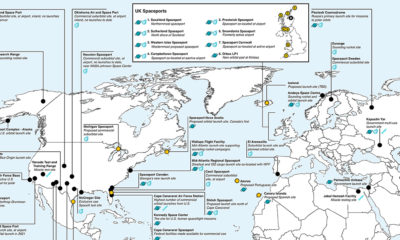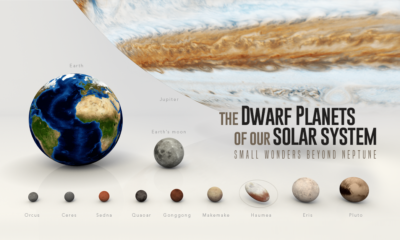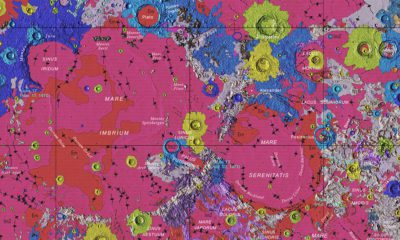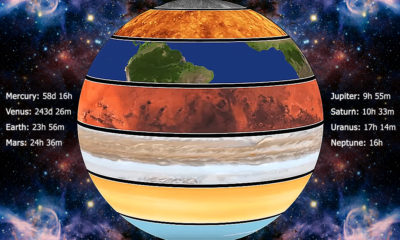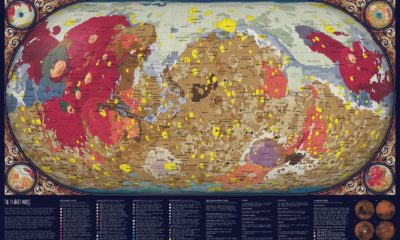While the Grand Canyon and Mount Everest are both impressive features on Earth, they are nothing next to Valles Marineris and Olympus Mons, their epic Martian counterparts.
Even more extraordinary, the overall difference between the highest and lowest point on Mars is 19 miles (31 km), whereas just 12 miles (20 km) separates the summit of Mount Everest from the bottom of the Mariana Trench on Earth.
This week’s map comes to us from Reddit user /hellofromthemoon, who carefully laid out the terrain of Mars in awesome detail.
Take a look…
Lay of the Land
Mars can be divided into two major regions, separated by a ridge of mountains roughly around the planet’s middle. On the north side are lowlands that have been shaped by lava flows, creating a surface dominated by large plains. Meanwhile, the southern hemisphere is mountainous, with many meteorite impact craters, some of which stretch for hundreds of kilometers. The Plains Game The plains of Mars fall into two categories: the planitia (Latin for “plains”) and the maria (Latin for “seas”). The latter type is named after the sea because these regions appeared to be under water in the eyes of early astronomers. But actually, the surfaces of these regions are covered with many rocks, making them look darker to the eye. The second type of plains are the planitia, and they account for vast areas covered by sand rich in iron oxide. The strong winds that blow the sand and dust around can change the configuration of the plains, forming new patterns on the surface of Mars. However, the planet’s features remain relatively unchanged over time. One of the largest plains is the Utopia Planitia (Latin for “Nowhere Land Plain”) impact basin. This giant impact crater lies within a larger lava plain. With an estimated diameter of 3,300 km, Utopia Planitia is the largest recognized impact basin in the solar system.
As Above, so Below
The northern and southern hemispheres are vastly different from one another on Mars, and such a stark difference is unlike any other planet in the solar system. Patterns of internal magma flow could have caused the variation, but some scientists think it is the result of Mars taking one or several major impacts. About 4.5 billion years ago, Mars formed from the collection of rocks that circle the sun before they formed the planets. Over time, the red planet’s molten masses differentiated into a core, a mantle, and an outer crust. Understanding how the red planet’s topography changes over time is a crucial step in grasping how the planet formed. That is why NASA launched the InSight Mars lander on May 5, 2019. This probe will listen for vibrations deep within the Martian crust to further understand the composition of the planet.
Site Selection
Understanding the topography of Mars is critical for any mission to the planet, including the selection of a site for a potential colony. There are three basic criteria for picking a manned mission landing site:
Brian Hynek, a planetary scientist and Director of the Center for Astrobiology at the University of Colorado at Boulder, offers five potential landing sites:
With growing information from every new mission to Mars, a greater picture will help guide future human activity and ambitions on the planet.
on
Even while political regimes across these countries have changed over time, they’ve largely followed a few different types of governance. Today, every country can ultimately be classified into just nine broad forms of government systems.
This map by Truman Du uses information from Wikipedia to map the government systems that rule the world today.
Countries By Type of Government
It’s important to note that this map charts government systems according to each country’s legal framework. Many countries have constitutions stating their de jure or legally recognized system of government, but their de facto or realized form of governance may be quite different. Here is a list of the stated government system of UN member states and observers as of January 2023: Let’s take a closer look at some of these systems.
Monarchies
Brought back into the spotlight after the death of Queen Elizabeth II of England in September 2022, this form of government has a single ruler. They carry titles from king and queen to sultan or emperor, and their government systems can be further divided into three modern types: constitutional, semi-constitutional, and absolute. A constitutional monarchy sees the monarch act as head of state within the parameters of a constitution, giving them little to no real power. For example, King Charles III is the head of 15 Commonwealth nations including Canada and Australia. However, each has their own head of government. On the other hand, a semi-constitutional monarchy lets the monarch or ruling royal family retain substantial political powers, as is the case in Jordan and Morocco. However, their monarchs still rule the country according to a democratic constitution and in concert with other institutions. Finally, an absolute monarchy is most like the monarchies of old, where the ruler has full power over governance, with modern examples including Saudi Arabia and Vatican City.
Republics
Unlike monarchies, the people hold the power in a republic government system, directly electing representatives to form government. Again, there are multiple types of modern republic governments: presidential, semi-presidential, and parliamentary. The presidential republic could be considered a direct progression from monarchies. This system has a strong and independent chief executive with extensive powers when it comes to domestic affairs and foreign policy. An example of this is the United States, where the President is both the head of state and the head of government. In a semi-presidential republic, the president is the head of state and has some executive powers that are independent of the legislature. However, the prime minister (or chancellor or equivalent title) is the head of government, responsible to the legislature along with the cabinet. Russia is a classic example of this type of government. The last type of republic system is parliamentary. In this system, the president is a figurehead, while the head of government holds real power and is validated by and accountable to the parliament. This type of system can be seen in Germany, Italy, and India and is akin to constitutional monarchies. It’s also important to point out that some parliamentary republic systems operate slightly differently. For example in South Africa, the president is both the head of state and government, but is elected directly by the legislature. This leaves them (and their ministries) potentially subject to parliamentary confidence.
One-Party State
Many of the systems above involve multiple political parties vying to rule and govern their respective countries. In a one-party state, also called a single-party state or single-party system, only one political party has the right to form government. All other political parties are either outlawed or only allowed limited participation in elections. In this system, a country’s head of state and head of government can be executive or ceremonial but political power is constitutionally linked to a single political movement. China is the most well-known example of this government system, with the General Secretary of the Communist Party of China ruling as the de facto leader since 1989.
Provisional
The final form of government is a provisional government formed as an interim or transitional government. In this system, an emergency governmental body is created to manage political transitions after the collapse of a government, or when a new state is formed. Often these evolve into fully constitutionalized systems, but sometimes they hold power for longer than expected. Some examples of countries that are considered provisional include Libya, Burkina Faso, and Chad.
